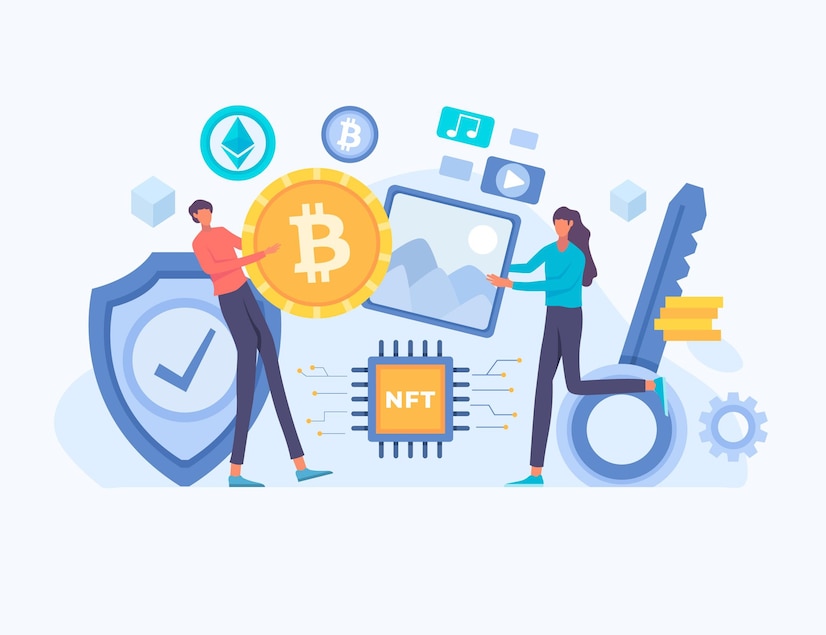The twenty-first century is a period of rapid development and technical progress. With each passing day, more and more innovations come into our lives. Many novel features appear that turn daily life upside down, improve and make it easier.
Whatever one may say, one of the important roles in society is played by money, and it would be strange if these important pieces of paper were left untouched by progress. In this article, I will tell you what cryptocurrency is, how it originated and how it is mined.
Cryptocurrency - What is crypto?
If in the past only the residents of the network had heard of the cryptocurrency, today it boasts an offline operation and has a considerable resonance in society. However, not everyone knows what it really is and where it comes from. Some do not believe that such money can exist in principle.
Others call cryptocurrency the hoax of the century and see it as a pyramid scheme. Of course, this cult has nothing to do with reality.
Cryptocurrencies are real money with virtual existence . But this doesn't stop you from paying with bitcoins in shops, cafes or exchanging for cash right at the ATM!
Cryptocurrency is a digital currency, its existence is based on the principle of cryptography. In simple human terms, these virtual currencies are unique cryptographic codes and have no physical analogues. It cannot be touched or put into a wallet, it only exists on the network and does not exceed its limits.
Cryptocurrency signs appear in an unusual way. If the money we are used to is issued by a certain issuer - the main bank of a particular country - then cryptocurrencies will appear without the involvement of any central authority. . New crypto tokens arise by generating new codes, executed by computers - even your PC is capable of doing that.
Furthermore, cryptocurrency is not centralized in a single repository, it is distributed among owners' wallets. There's no sign of cryptocurrencies that don't belong to anyone - they're all stored in real users' wallets (except for the lost ones, but I'll talk about this later).
From all of the above, it can be seen that no one can control the catacombs, somehow adjust its process, quantity, production in other ways not provided by its nature. This is a huge step forward, because for the first time money does not depend on the issuer, the economic or political situation in the world.
The exchange rate depends on demand for it : the more people want to buy a particular cryptocurrency, the higher its price, and vice versa. The exchange rate also depends on the excitement around the currency and on the big investors.
And the number of people who want to buy cryptocurrency is increasing every day. Some buy it for the benefit and future prospects, others gain from the course, and some succumb to the general excitement. Anyway, she's famous.
And if a few years ago almost no one in the offline environment knew what cryptocurrency is, today there is a real crypto movement, when not only explorers, investors, experts IT and network carriers but also government agencies pay attention to it.
Advantages and disadvantages of cryptocurrencies
In many ways, this excitement is facilitated by the advantages of cryptocurrencies, many of which are:
- Decentralized - cryptocurrency has no right to issue and control it.
- Anonymous - each crypto token user remains unknown. After all, your personal data is not revealed when signing up for a wallet, or when using it, or in transactions - completely secure.
- Exchange rate volatility - almost all cryptocurrencies are characterized by high volatility, i.e. their rates fluctuate non-stop and in different directions. For example, by buying a bitcoin in the morning and selling it in the evening after the rate rises, you can become instantly rich with a few hundred dollars.
- Mining opportunity - anyone who wants can start mining cryptocurrencies and it's completely free.
- Inflation is not possible - most cryptocurrencies can only be created up to a certain predetermined number (for example, for bitcoin, 21 million coins).
However, catacombs have not only advantages, but also some disadvantages. First of all, it has no official status, and in some countries it is even banned. And its anonymity contributes to the fact that Internet scammers use it with great activity.
Well, what doesn't complement crypto is that if the password is lost, the funds on the wallet are automatically lost - without authorization you can't access it.
History of cryptocurrency
It should be noted right away that cryptocurrency appeared at the exact moment when humanity began to need it. The instability of fiat money, inflation, and the wave of crises that swept through many European countries contributed to a society that simply needed independent and reliable money.
In 2008, they first started talking about cryptocurrencies, although within a rather narrow circle of IT professionals. The impetus for this was the publication of a paper on the first virtual currency based on cryptographic principles - Bitcoin.
A certain Satoshi Nakamoto outlined his concept of cryptocurrency. And conversations will still be conversations, but a year later the Bitcoin network was launched, and then the first wallets, laying the groundwork for a new crypto era.
Bitcoin mining has begun, albeit inactive. Many IT professionals did not fully understand what cryptocurrency is and what prospects it could have. Someone mines bitcoins for profit, someone still sees them as the money of the future.
But perhaps no one, except its creator, understands the heights that the pioneer of crypto-currencies can achieve. Satoshi Nakamoto mines bitcoins on special equipment, while others use simple computers, which makes him 1 million coins.
By the way, it is not known for sure whether the founder of bitcoin was a separate person or a group of people, but very soon Nakamoto disappeared. And with it, the track and a million cue balls were lost.
Many economists assume that if Satoshi suddenly appeared and decided to sell his crypto tokens, it would shake up the bitcoin rate and arrange a real crash for MTC holders.
Pizza worth 10,000 BTC
The Bitcoin system has been improved, errors and omissions have been eliminated, and at this point, working cryptocurrency mining is done. In 2010, the first cue ball purchase took place. One of the miners, who had accumulated 10,000 BTC, exchanged them for two pizzas, at an exchange rate at the time of $50.
This sale went down in history as not only the first bitcoin exchange for goods, but also the most expensive pizza in human history - at current exchange rates, the purchase is around 24 million dollars!
Pizza for 10k bitcoins is not the only case when crypto is being treated very harshly. Tens of thousands of bitcoins have disappeared along with the equipment in which they were mined. After all, many of their owners, after the PC crashed, didn't think it was worth it to get rid of the hard drive with the current expensive crypt.
But the days of bitcoin skepticism are over, its rate is starting to increase rapidly. And with this, sprouting like mushrooms after the rain, new cryptocurrencies began to appear - forks (English word is fork - fork), altcoins, which are launched daily and are difficult to calculate. number of active cryptocurrencies.
Cryptocurrency Mining
Thanks to the open source code, anyone with a computer device and an Internet connection can participate in cryptocurrency mining (English word mining). At the same time, your personal computer will do a pretty good job of extracting many crypto tokens.
The nature of mining is reduced to solving complex mathematical problems, so that new blocks of information are opened, which are a certain sequence of ones and zeros.
One person cannot solve such problems on their own, but computer technology is quite capable of doing it. Unresolved blocks are transferred to the network and miners receive rewards in the form of crypto tokens.
It is quite logical that the more unique blocks that are solved, the harder it is to find new blocks and the more effort the technique must put into this process. This leads to the more mining of one cryptocurrency or another, the more difficult the process becomes and the less rewards the miner gets.
For example, initially bitcoin is mined with PC effort and the block reward is 50 BTC. After actively connecting users around the world to the mining process, bitcoin mining became more difficult. The computer has become an inefficient miner, as the bitcoins obtained this way do not even include electricity.
Since the number of cues is limited by the number of final generations, the block reward at certain intervals will be halved. Today the remuneration is 12.5 BTC.
Despite the decrease in rewards and increased complexity, miners still do not stop mining, although many experts admit that these two factors can seriously reduce the number of miners and thus lead to a decline in the number of miners. decrease in cryptocurrencies.
The fact is that technical progress does not stand still and mining capacity is also improving. The latest ASIC miners can solve hundreds of thousands of tasks more than PCs and even with reduced power consumption.
Confirm transactions and mining
Mining not only plays a role in mining cryptocurrency tokens but also in confirming transactions. To transfer bitcoins or other coins from wallet to wallet, it is necessary not only to complete the transaction, but also to have it confirmed by other participants in the system.
That is, write this operation to the blockchain, that's what miners do. For this, they receive a reward in the amount determined by the initiator of the transfer.
The more commission you are willing to pay, the faster the confirmation will be completed. There are commission-free transfer options, but at best they are done within a few days and at worst the funds can be frozen or if transfer confirmation is not received, returned to the owner's wallet owned.
Why do we need transaction confirmation? This is a kind of system protection - cybercriminals perform fake transactions that require huge amounts of computing power. It has been determined that in order to forge 6 confirmations, a hacker must have several million dollars worth of computing equipment, which reduces the risk of being hacked to a minimum.
The most popular cryptocurrencies
So, we talked about what cryptocurrency is, where it comes from and how it is mined. It's time to talk about the most popular and favored cryptocurrencies that exist in our time.
As I mentioned, after the success of Bitcoin, cryptocurrencies began to actively launch and many of them have reached a good level of development and distribution. While none of the bros can beat the cue ball, many of the crypto signs described below have a real chance of competing with it.
Bitcoin (BTC) is the most popular cryptocurrency. Pioneer with a market capitalization of over $40 billion. In addition, bitcoin is also the most expensive coin - its rate at the time of this writing is $60,610 per 1 BTC.
This is the most popular cue - it is recognized at the state level in many countries, offline terminals are installed and used as an investment tool. More about BTC: how to create a bitcoin wallet, overview of bitcoin storage services.
Ethereum (ЕТН) is a cryptocurrency invented by a young developer of Russian origin Vitalik Buterin. Ethereum, aka ether, is not a fork of bitcoin and uses its own source code, on the basis of which many cryptocurrencies have emerged. The ether rate reached $222 per 1 ETH and the capitalization reached $20 billion. It is Ethereum that is considered the main competitor of Bitcoin.
Ripple (XRP) - Launched in 2012. In terms of capitalization, it is the third coin - $11.5 billion and the rate is $0.29 per coin. The Ripple protocol is widely used by both banking structures and payment systems, which is explained by a number of advantages that bitcoin does not possess (no commissions, instant transfers, etc.).
Litecoin (LTC) is a fork of bitcoin, launched in 2011, that has gained considerable popularity. The cryptocurrency rate is $27, the capitalization is $1.4 billion.
NEM (SEE) is a second generation cryptocurrency that calls itself "socially oriented". At $0.22, the market cap is over $2 billion.
Dash (DASH) - appeared in 2014 as XCoin, then went through first (Darkcoin) and second (Dash) rebranding. It is recognized as a currency of an improved pattern, because, unlike bitcoin, it features anonymization of transactions, reduced energy costs for mining, and the use of several cryptographic algorithms. simultaneous. Course is $145, capitalization over $1 billion.
Of course, these are far from all popular cryptocurrencies, there are many more, but I think these are the main ones that a modern netizen should be familiar with. If you are a beginner, then you can buy your first cryptocurrency right now using crypto exchange devices.
I hope my article helped you learn more about what cryptocurrencies are and was helpful.





